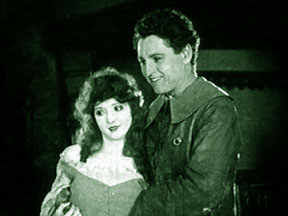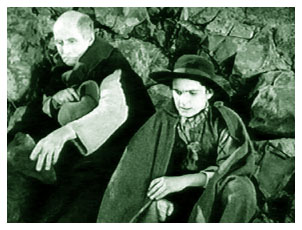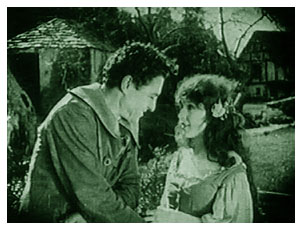

Lorna and John Ridd are 17th century childhood sweethearts. Lorna is kidnapped by a feared band of highwaymen who terrorize the countryside and have a well-fortified community in the rocky hillside country that no one dare attempt to impregnate.
The patriarch of this community, Sir Ensor Doone, raises her as his own, keeping the secret of her royal blood from her. Years later, when both are adults, John is swept down the river's rapids and over a large waterfall. When he awakes, he finds himself on the bank with his head in Lorna's lap. They arrange a signal from a hilltop if she ever needs him, but he must leave quickly to avoid getting caught by the Doones.
More years pass, and Ensor is on his deathbed. The lecherous Carver Doone seizes this opportunity to try and force Lorna into marrying him. Lorna's maid signals for John's help from the hilltop, and he rescues her from the Doones.
In a last noble gesture before dying, however, Ensor had
sent a message to London so that Lorna's royal heritage would
be known. When a countess shows up to take Lorna to London, John
nobly, but reluctantly, tells her she should go. However, she
later renounces her heritage and comes back to John. During their
wedding ceremony, Carver shoots Lorna through the window. Considering
this to be the final straw, John and the men of the nearby towns
storm the Doone stronghold. This desperate  gesture
may cost them their lives.
gesture
may cost them their lives.
"Lorna Doone" is a good movie, but the first adjective that comes to mind after watching it is "uninspired." One gets the feeling that there's something seething under the surface that could be great, but it never emerges.
Harrison's Reports (December 9, 1922) said, "'Lorna Doone' is a good picture, although there are no particularly outstanding situations in the plot: it contains nothing that other good pictures do not possess."
In a forward to Madge Bellamy's autobiography (A Darling of the Twenties, Vestal Press, 1989), film historian and producer Kevin Brownlow said, "I have seen 'Lorna Doone' (1922) and I have to admit that while it was directed by a man for whom I have the highest admiration (the Frenchman Maurice Tourneur), the picture is a sad disappointment. Tourneur betrayed the story in a way that shows he was more interested in form than content."
Madge Bellamy herself said, "In the development of the story, 'Lorna Doone' is a failure, but it succeeds like a poem in capturing the mood of the novel. Tourneur was a pictorial artist. . . The narrative, to him, expressed nothing. . . 'Lorna Doone,' to him, was sentimental and childish. He cared nothing for it. He was a typical elitist with no message to give or receive." (from A Darling of the Twenties)
Although Bellamy's assessment may be a little harsh, it is somewhat frustrating that the look and the "feel" of the film give you the impression you're watching a photoplay of exceptional quality, but, in the final analysis, you walk away feeling that it didn't quite measure up. There's a sense of being "let down" or being on the receiving end of an unfulfilled promise.
"Lorna Doone" is from a novel of the same name by R.D. Blackmore and was considered a literary classic at the time the film was made. Novels are notoriously difficult to translate to film without substantial rewriting to condense the narrative. Of course, today, that problem is solved by making a miniseries, but condensing a story, particularly one that covers a number of years such as this one, creates a challenge for the scenarist and director. However, neither Tourneur as director or Tourneur as scenarist with the help of three co-writers, rose to that challenge. The Variety (December 8, 1922) reviewer astutely noted, "Pictorially, the film is a splendid effort, although it has most of the faults of dramatized books, principally that it is episodic in its dramatic unity and is loosely knit. The story is jumpy with disconnected leaps . . ."
 The film begins with an encounter
between Lorna and John Ridd as adolescents, however, it is unclear
if this is their first meeting or if they knew each other before.
Only through an intertitle do we learn they are "sweethearts."
Tension is built when we are told there are "highwaymen"
about as Lorna and her mother ready to continue their trip in
their carriage. Her mother dismisses the danger by noting that
the robbers "never attack ladies." However, just as
we suspect, they are attacked, robbed and Lorna kidnapped while
John and his father watch from afar, unable to take any action
against the large band of highwaymen.
The film begins with an encounter
between Lorna and John Ridd as adolescents, however, it is unclear
if this is their first meeting or if they knew each other before.
Only through an intertitle do we learn they are "sweethearts."
Tension is built when we are told there are "highwaymen"
about as Lorna and her mother ready to continue their trip in
their carriage. Her mother dismisses the danger by noting that
the robbers "never attack ladies." However, just as
we suspect, they are attacked, robbed and Lorna kidnapped while
John and his father watch from afar, unable to take any action
against the large band of highwaymen.
Unanswered questions and unresolved incidents weaken a story, and one such dilemma arises from the robbery scene. We see Lorna's mother lying in the surf following the robbery, but we have no idea of her fate. Is she dead? If so, we didn't see the murderous act. If not, why didn't John and his father go to her aid after the robbers left? She's never mentioned again in the story.
An intertitle tells us that several years pass, and the two children have grown into adulthood. Lorna has become favored - in a paternal sense - by Sir Ensor who also serves as her protector from the wild band of Doones. She spends her time with birds and flowers and books, rather than the rowdy Doone clan.
John has grown to be the strongest man in Devonshire, and his strength is demonstrated when he stands waist deep in the rapids and tosses a large log. However, the rapids finally get the best of him, and he is swept down the river and over a waterfall. Awakening from his unconsciousness, he finds himself looking into the face of Lorna who is holding his head in her lap. Their meeting is brief, because John must leave before he is discovered in Doone territory. Lorna tells him to leave by way of the moors to escape undetected. At this point, we are a little puzzled as to why she doesn't leave with him. Although he tells her to signal him from a hilltop if she ever needs him, they part with no plan to ever meet again.
Any story is enhanced by the presence of a sufficiently menacing villain, and the character of Carver Doone, somewhat overacted by the obscure Donald MacDonald, provides emotional impact to the story. We are introduced to Carver in a scene where he is manhandling a young maiden as several other men encourage him. Lorna sees this and steps in. Carver doesn't dare defy her because of Sir Ensor. However, the scene effectively establishes his despicable character.
Later, when Sir Ensor is dying and helpless, Carver, drunkenly and defiantly in the presence of Sir Ensor, manhandles Lorna. He then summons the Blink Monk to perform a marriage ceremony which results in a last minute rescue scene that has us gripping the armrests of our seats.
In a final despicable act, Carver shoots Lorna just as she and John are being married. It is not clear whether he was intending to shoot John and missed, but, either way, we are brought to an emotional level that demands something be done to stop this clan from continuing their reign of terror. That is why John's ensuing rage and the banding together of the men in the villages with him to finally go after the Doones is such a rousing climax to the story.
If all the pieces of the story worked as well as the villain's role, the film would have been a much stronger presentation. For example, after John rescues Lorna from a forced marriage to Carver, we see the two lovers finally reunited. Their union is short-lived, however, as the Countess of Brandir arrives from London to take Lorna back with her.
We now enter a segment of the story where Lorna has gone
to live out her royal heritage in London. John decides to go visit
her, and wins the admiration of the king when  he
foils an attempted assassination during the Royal Prince's baptism.
The admiration is quickly lost, though, when he picks up the infant
Prince to play with him. The entire court is appalled that he
would dare to touch the royal child, and the king comments, "I
have wasted my praise on a clown." When John realizes everyone
is laughing at him, he runs from room and goes back home, dejected
and embarrassed. Before long, though, Lorna returns. She has renounced
her title for John's love.
he
foils an attempted assassination during the Royal Prince's baptism.
The admiration is quickly lost, though, when he picks up the infant
Prince to play with him. The entire court is appalled that he
would dare to touch the royal child, and the king comments, "I
have wasted my praise on a clown." When John realizes everyone
is laughing at him, he runs from room and goes back home, dejected
and embarrassed. Before long, though, Lorna returns. She has renounced
her title for John's love.
This is all there is to this portion of the story. First of all, John's experience in London elicits little sympathy from the viewer, although it was obviously intended to do so. Secondly, the whole sequence is essentially disconnected to what precedes it and what follows. Although this may have been an attempt by Tourneur to stay as true to the novel as possible, it would have been much more advisable to continue the emphasis on the conflict with the Doones. After all, after John rescued Lorna from her wedding with Carver, why wasn't there any threat of retaliation by the Doones? Again, this continues to reinforce the Variety reviewer's opinion that the story is "episodic" and "loosely knit."
Of course, any film can be more enjoyable to watch if one
views it with a less critical eye. That is the case with "Lorna
Doone" because this film also has much to recommend it. Madge
Bellamy as Lorna is a delight to behold - certainly one of the
most beautiful actresses of the silent era. Her acting is far
from Academy Award proportions, but the beauty, the charm, the
innocence, the vulnerability and the appeal of the character make
her a good choice for the part.
Variety said, "Madge Bellamy has just the right wistful
quality of beauty for Lorna." Brownlow said the film "came
early in Madge Bellamy's career when she admits she was more interested
in looking beautiful than in portraying a character. And she undoubtedly
succeeded. . . Madge poses through the film as if being painted,
and she looks very impressive. Although she loved the novel and
empathized with the character, none of that comes through in the
film."
John Bowers, who, unfortunately, did not make a very memorable impression in silent films, does a commendable job as John Ridd. He does not overact, and presents his character with the appropriate restraint while displaying the emotion necessary for each scene. He is at his weakest in the fight scenes, but there are moments, especially in the final fight with Carver, that show some sparks of excitement. The New York Times would only label both Bellamy's and Bowers' performances as "satisfactory," while Variety gave a little more praise to him - unfortunately using the wrong name -- noting, "Frank (sic) Bowers realizes fairly well the Blackmore hero."
Frank Keenan, the venerable character actor, was singled out for the most praise. "The histrionic honors, however, go to that best of character portrait makers, Frank Keenan, as Sir Ensor Doone," said Variety, and The New York Times added, "The acting of the photoplay is satisfactory, for the most part, hardly more than that in some cases, but decidedly more in the case of Frank Keenan as Sir Ensor."
 "Lorna
Doone" is, pictorially, a beautiful film
"Lorna
Doone" is, pictorially, a beautiful film"Lorna Doone" is, pictorially, a beautiful film. For that, Tourneur deserves credit. Bellamy however, was not impressed with his attention to the visual, and, as noted above, felt the director did not like the story and did not take an interest in its content. An example of this, she said, was when it came time to film the wedding scene. "Once I was late on the set; Mr. Tourneur would wait no longer, and he shot my wedding scene without me . 'How could you?' I asked him. 'I had to,' he replied. 'The clouds were exactly right.' If you look closely at the march to the church in 'Lorna Doone,' you will not see me - the bride."
In addition to an authentic "air" for the period, the film contains some occasional stunning photography. When the young Lorna and her mother leave Devonshire in their carriage, it is late in the day with shadows beginning to form. A long-shot of the carriage moving across the moors and silhouetted against the darkening sky is very pleasing, indeed. Tourneur continues to make use of this device with a shot of the highwaymen on horseback silhouetted atop rolling hills.
Variety praised the visual charm of the film. "The scenic features of the picture have been splendidly managed. The stage coach inn might have been lifted from an authentic print of the times. The spirited passage of the coach robbery on the seashore is a smashing bit of pictorial emphasis and the action in the robbers' village is scenically impressive. So is the ceremonial pageantry of the royal christening and the marriage of the hero and heroine in the village church. Misted photography is used to fine effect and the backgrounds are always beautiful."
"Lorna Doone" obviously hasn't stood up as one of the greatest or most memorable films of the silent era, but it is good entertainment in spite of its lost potential. The fact that is was based upon one of the most popular love stories of the time assured it at least some modicum of success, but its translation to the screen was, based on reviews, not completely satisfactory to those who knew the book. It is of great interest to silent movie fans, though, due to the two main players. Too few of Madge Bellamy's films have survived, and so we are fortunate that this film remains in excellent condition and is available for the home video market. She is a beautiful and competent actress who deserves more attention from historians than she has received. John Bowers' somewhat baby-faced looks were best suited to a role such as the preacher in King Vidor's "The Sky Pilot" (1921), a film in which he performed excellently. He is adequate for the role of John Ridd in "Lorna Doone," but a more rugged player would have been better suited for this type of heroic role. Unfortunately, Bowers is mainly remembered for the decline of his career after the silent era and eventual suicide in the 1930's, a suicide many believe was immortalized in "A Star Is Born" (1937)
Kino's DVD release is a beautiful print, and the original
art titles add much to the enjoyment of the film. It includes
an original score by Mari Iijima, which, to its credit, fits the
period in which the story takes place well. Unfortunately, it,
too, like the film, is uninspired. Themes are repeated over and
over, which at some points in the film, actually become annoying.
Oddly enough, the tone of the accompaniment doesn't always change
with the scene. For example, the attempted assassination of the
Royal Prince during the baptismal ceremony is a gripping and exciting
point in the film, but the music continues in its steady, moderate
tone and adds nothing to excitement of this moment.
Copyright 2005 by Tim Lussier. All rights reserved.